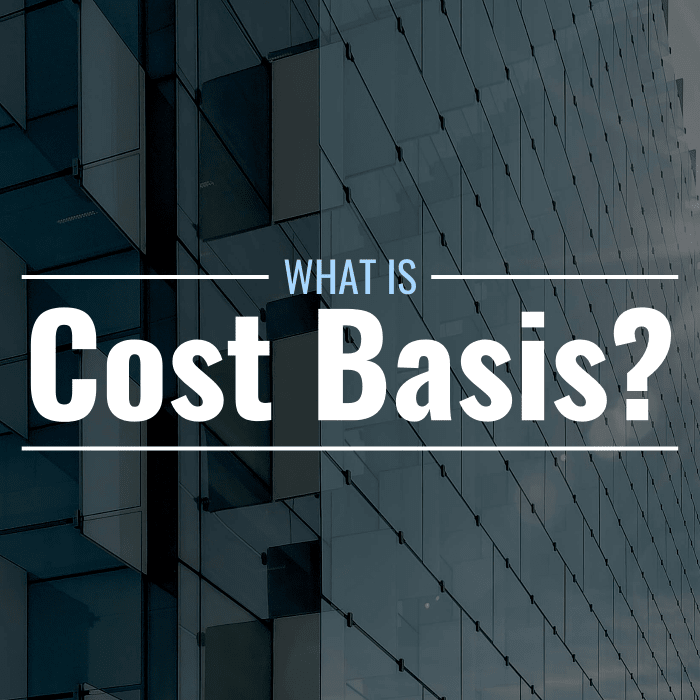What Is Cost Basis? Definition, Example & Tax Implications

When an investor sells an asset, their cost basis is used to calculate their capital gains (or losses) for tax purposes.
What Is a Cost Basis?
An investor’s cost basis is the amount they paid for an asset when they purchased it, including any commissions or other fees (e.g., sales loads) associated with the purchase. Once an investor sells an asset, their cost basis is used to calculate their capital gains (or losses) for tax purposes.
Any time you sell a stock, a property, a commodity, or even a derivative security like a call option, your cost basis is used to calculate your capital gains or losses, which are then used to determine what you owe in taxes.
Cost Basis Example With Tax Implications
If an investor bought 50 shares of Acme Adhesives at $10 per share and didn’t pay any commission fees, then sold them two years later for $20 per share, their cost basis would be $500 ($10 * 50 shares). To calculate their capital gains, they would subtract their cost basis from the total amount they received from the sale of the shares:
Cost basis: $500
Sale price: $1000Capital gains = Sale price - Cost basis
Capital gains = $1000 – $500
Capital gains = $500
Because the investor held the shares for over a year, their gains would be taxed at the long-term rate. If they fell into the 15% long-term capital gains tax bracket, they would owe $75 (0.15 * $500) in capital gains taxes for the sale of their 50 shares.
Can Cost Basis Change Over Time?
An investor’s cost basis can change over time if they continue to purchase shares of an asset at different prices. If an investor wanted to calculate their per-share cost basis for a particular stock or ETF that they purchased shares of on more than one occasion, they would simply divide the total amount they paid for all of their shares by the number of shares they own.
For instance, if an investor bought 15 shares of a stock at $5 per share, then bought 10 more shares a week later at $6 per share, their per-share cost basis would be calculated as follows:
Cost basis per share = Total price paid for all shares / Total shares owned
Total price paid for all shares = (15 * $5) + (10 * $6)
Total price paid for all shares = ($75) + ($60)
Total price paid for all shares = $135Total shares owned = 25
Cost basis per share = $135 / 25
Cost basis per share = $5.40
What Is Included in the Cost Basis of an Investment?
At its most basic level, an investment’s cost basis is its purchase price. In practice, however, additional factors often come into play. Any fees associated with the purchase of an asset are included in that asset’s cost basis. Many brokerages now allow for fee-free stock trading, so brokerage commissions aren’t as common as they once were, but certain investments, like mutual funds, may still come with fees like sales loads, and these fees increase an investment’s cost basis.
Fees aren’t the only things that can affect cost basis, though. When it comes to stocks and equity funds, reinvested dividends are included in the calculation of cost basis. When it comes to real estate, the costs of any improvements made to a property are added to its cost basis as well.
Frequently Asked Questions (FAQ)
Below are answers to some of the most common questions investors have about cost basis that were not already covered in the sections above.
How Do Reinvested Dividends Affect Cost Basis?
When an investor uses the dividends from a stock or fund to buy more shares, their cost basis increases by the amount invested, and their per-share cost basis changes accordingly—it goes up if dividends are reinvested at a price higher than their existing average, and it goes down if dividends are reinvested at a lower price.
What Is the Cost Basis of a Futures Contract?
The cost basis of a futures contract is the difference between the current cash price of the underlying commodity and its futures price.
What Is the Cost Basis of a Real Estate Property?
The cost basis for a real estate property is its purchase price including fees plus the cost of any capital improvements made to the property over the course of its ownership.
What Is the Cost Basis of a Gifted Investment?
The cost basis of a gifted asset depends on the fair market value of that asset at the time of transfer. If an asset is worth more than it was purchased for when it is gifted, the recipient assumes the donor’s cost basis. This means that any capital gains or losses they incur from the sale of that asset are based on the donor’s cost basis.
If, on the other hand, the asset is worth less than it was purchased for at the time of transfer, the recipient’s cost basis depends on how much they sell the asset for. If they sell it for less than the donor’s cost basis but more than the fair market value at the time of transfer, they are not taxed. If they sell it at any other price, their cost basis is the fair market value of the asset at the time of transfer.
What Is the Cost Basis of an Inherited Investment?
When someone inherits an asset, their cost basis is the fair market value of that asset at the time of transfer.
